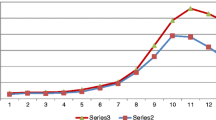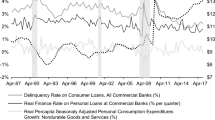Abstract
This paper addressed the neglected area of modelling recovery from delinquency to normal performance on retail consumer loans taking into account the recurrent nature of delinquency and also including time-dependent macroeconomic variables. Using data from a lending company in Zimbabwe, we provided a comprehensive analysis of the recovery patterns using the extended Cox model. The findings vividly showed that behavioural variables were the most important in understanding recovery patterns of obligors. This confirms and underscores the importance of using behavioural models to understand the recovery patterns of obligors in order to prevent credit loss. The study also points to the urgent need for policy measures aimed at promoting economic growth for the stabilisation of consumer welfare and the financial system at large.

Source: RBZ (2015). Mid-term monetary policy statement. July 2015.

Source: RBZ (2015). Mid-term monetary policy statement. July 2015.






Similar content being viewed by others
References
Altman, E.I. (1968) Financial ratios, discriminant analysis and the prediction of corporate bankruptcy. Journal of Finance 23(4): 589–609.
Andersen, P.K. and Gill, R.D. (1982) Cox’s regression model for counting processes: A large sample study. The Annals of Statistics 10: 1100–1120.
Andersen, P.K., Borgan, O., Gill, R.D. and Keiding, N. (1993) Statistical Models Based on Counting Processes. New York: Springer.
Baesens, B., Gestel, T., Viaene, S., Stepanova, M., Suykens, J. and Vanthienen, J. (2003) Benchmarking state-of-the-art classification algorithms for credit scoring. The Journal of the Operational Research Society 54(6): 627–635. doi:10.1057/palgrave.jors.2601545.
Banasik, J., Crook, J.N. and Thomas, L.C. (1999) Not if but when will borrowers default. Journal of the Operational Research Society 50(12): 1185–1190. doi:10.1057/palgrave.jors.2600851.
Bellotti, T. and Crook, J. (2013) Forecasting and stress testing credit card default using dynamic models. International Journal of Forecasting 29(4): 563–574. doi:10.1016/j.ijforecast.2013.04.003.
Bentz, Y. and Merunka, D. (2000) Neural networks and the multinomial logit for brand choice modelling: A hybrid approach. Journal of Forecasting 19: 177–200.
Castro, V. (2013) Macroeconomic determinants of the credit risk in the banking system: The case of the GIPSI. Economic Modelling 31(1): 672–683. doi:10.1016/j.econmod.2013.01.027.
Chen, W., Xiang, G., Liu, Y. and Wang, K. (2012) Credit risk evaluation by hybrid data mining technique. Systems Engineering Procedia 3: 194–200. doi:10.1016/j.sepro.2011.10.029.
Cox, D.R. (1972) Regression analysis and life table. Journal of the Royal Statistical Society. Series B (Methodological) 34(2): 187–222.
Einav, L., Jenkins, M. and Levin, J. (2013) The impact of credit scoring on consumer lending. RAND Journal of Economics 44(2): 249–274. doi:10.1111/1756-2171.12019.
Fantazzini, D. and Figini, S. (2009) Random survival forests models for SME credit risk measurement. Methodology and Computing in Applied Probability 11(1): 29–45. doi:10.1007/s11009-008-9078-2.
Gupta, J., Gregoriou, A. and Ebrahimi, T. (2015) Using Hazard Models Correctly: A Comparison Employing Different Definitions of SMEs Financial Distress. Available at SSRN: http://ssrn.com/abstract=2457917. Accessed 20 January 2016.
Ha, S.H. (2010) Behavioral assessment of recoverable credit of retailer’s customers. Information Sciences 180(19): 3703–3717. doi:10.1016/j.ins.2010.06.012.
Hand, D.J. (2006) Rejoinder: Classifier technology and the illusion of progress. Statistical Science 21(1): 1–14. doi:10.1214/088342306000000079.
Hand, D.J. and Henley, W.E. (1997) Statistical classification methods in consumer credit scoring: A review. Journal of the Royal Statistical Society 160(3): 523–541. doi:10.1111/j.1467-985X.1997.00078.
Henebry, K.L. (1997) A test of the temporal stability of proportional hazards models for predicting bank failure. Journal of Financial and Strategic Decisions 10(3): 1–11.
Ho Ha, S. and Krishnan, R. (2012) Predicting repayment of the credit card debt. Computers and Operations Research 39(4): 765–773. doi:10.1016/j.cor.2010.10.032.
Hosmer, D.W., Lemeshow, S. and Sturdivant, R.X. (2013) Applied Logistic Regression, 3rd edn. Wiley Series in Probability and Statistics. doi:10.1002/0471722146.
Huang, J.J., Tzeng, G.H. and Ong, C.S. (2006) Two-stage genetic programming (2SGP) for the credit scoring model. Applied Mathematics and Computation 174(2): 1039–1053. doi:10.1016/j.amc.2005.05.027.
Jorion, P. (2003) Financial Risk Manager Handbook, 2nd edn. Hoboken, NJ: Wiley.
Kalbfleisch, J.D. and Prentice, R.L. (1980) The Statistical Analysis of Failure Time Data, Vol. 5. New York: Wiley. doi:10.1002/9781118032985.
Kelly, R. and O’Malley, T. (2016) The good, the bad and the impaired: A credit risk model of the Irish mortgage market. Journal of Financial Stability 22: 1–9. doi:10.1016/j.jfs.2015.09.005.
Kleinbaum, D.G.D. and Klein, M. (2011) Survival Analysis: A Self-learning Text, 3rd edn. New York: Springer.
Kruppa, J., Schwarz, A., Arminger, G. and Ziegler, A. (2013) Consumer credit risk: Individual probability estimates using machine learning. Expert Systems with Applications 40(13): 5125–5131. doi:10.1016/j.eswa.2013.03.019.
Lando, D. (1994) Three essays on contingent claims pricing. PhD Thesis, Cornell University, Ithaca, NY.
Lim, M.K. and Sohn, S.Y. (2007) Cluster-based dynamic scoring model. Expert Systems with Applications 32(2): 427–431. doi:10.1016/j.eswa.2005.12.006.
Lin, D.Y. and Wei, L.J. (1989) The robust inference for the Cox proportional hazards model. Journal of the American Statistical Association 84(408): 1074–1078. doi:10.2307/2290085.
Malik, M. and Thomas, L.C. (2012) Transition matrix models of consumer credit ratings. International Journal of Forecasting 28(1): 261–272. doi:10.1016/j.ijforecast.2011.01.007.
Narain, B., Thomas, L.C., Crook, J.N. and Edelman, D.B. (1992) Survival analysis and the credit granting decision. In: Credit Scoring and Credit Control (pp. 109–121). Oxford, UK: OUP.
Noh, H.J., Roh, T.H. and Han, I. (2005) Prognostic personal credit risk model considering censored information. Expert Systems with Applications 28(4): 753–762. doi:10.1016/j.eswa.2004.12.032.
PRMIA (2011) The Professional Risk Managers’ Handbook Series, 2011. Risk Management Practices, Vol. III. Wilmington: PRMIA Publications.
Rampone, S., Frattolillo, F. and Landolfi, F. (2013) Assessing consumer credit applications by a genetic programming approach. Advanced Dynamic Modeling of Economic and Social Systems 448: 79–89. doi:10.1007/978-3-642-32903-6_7.
RBZ. (2010) Monetary Policy Statement. Harare: Reserve Bank of Zimbabwe.
RBZ. (2015) Mid-term Monetary Policy Statement. Harare: Reserve Bank of Zimbabwe.
Russell, S.J. and Norvig, P. (2003) Artificial Intelligence: A Modern Approach, 2nd edn. Upper Saddle River, NJ: Prentice Hall.
Sarlija, N., Bensic, M. and Zekic-Susac, M. (2009) Comparison procedure of predicting the time to default in behavioural scoring. Expert Systems with Applications 36(5): 8778–8788. doi:10.1016/j.eswa.2008.11.042.
Stepanova, M. and Thomas, L.C. (2002) Survival analysis methods for personal loan data. Operations Research 50(2): 277–289. doi:10.1287/opre.50.2.277.426.
Tong, E.N.C., Mues, C. and Thomas, L.C. (2012) Mixture cure models in credit scoring: If and when borrowers default. European Journal of Operational Research 218(1): 132–139. doi:10.1016/j.ejor.2011.10.007.
Whalen, G. (1991) A proportional hazards model of bank failure: An examination of its usefulness as an early warning tool. Economic Review 27(1): 21–31.
Zeger, S.L. and Liang, C.Y. (1986) Longitudinal data analysis for discrete and continuous outcomes. Biometrics 42(1): 121–130. doi:10.2307/2531248.
Author information
Authors and Affiliations
Corresponding author
Rights and permissions
About this article
Cite this article
Chamboko, R., Bravo, J.M. On the modelling of prognosis from delinquency to normal performance on retail consumer loans. Risk Manag 18, 264–287 (2016). https://doi.org/10.1057/s41283-016-0006-4
Published:
Issue Date:
DOI: https://doi.org/10.1057/s41283-016-0006-4




